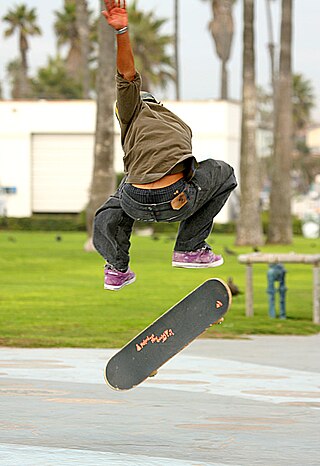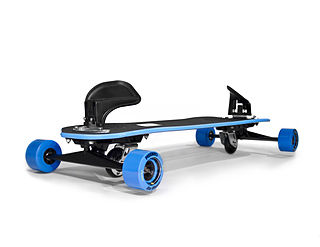Related Research Articles

Snowboards are boards where the user places both feet, usually secured, to the same board. The board itself is wider than most skis, with the ability to glide on snow. Snowboards widths are between 6 and 12 inches or 15 to 30 centimeters. Snowboards are differentiated from monoskis by the stance of the user. In monoskiing, the user stands with feet inline with direction of travel, whereas in snowboarding, users stand with feet transverse to the longitude of the board. Users of such equipment may be referred to as snowboarders. Commercial snowboards generally require extra equipment such as bindings and special boots which help secure both feet of a snowboarder, who generally ride in an upright position. These types of boards are commonly used by people at ski hills, mountains, backcountry, or resorts for leisure, entertainment, and competitive purposes in the activity called snowboarding.

Snowboarding is a recreational and competitive activity that involves descending a snow-covered surface while standing on a snowboard that is almost always attached to a rider's feet. It features in the Winter Olympic Games and Winter Paralympic Games.
Boardsports are active outdoor sports that are played with some sort of board as the primary equipment. These sports take place on a variety of terrains, from paved flat-ground and snow-covered hills to water and air. Most boardsports are considered action sports or extreme sports, and thus often appeal to youth. Some board sports were marginalized in the past. However, many board sports are gaining mainstream recognition, and with this recognition, they have enjoyed wider broadcast, sponsorship and inclusion in institutional sporting events, including the Olympic Games.

A surfboard is a narrow plank used in surfing. Surfboards are relatively light, but are strong enough to support an individual standing on them while riding an ocean wave. They were invented in ancient Hawaii, where they were known as papa he'e nalu in the Hawaiian language, and were usually made of wood from local trees, such as koa. They were often over 460 cm (15 ft) in length and extremely heavy. Major advances over the years include the addition of one or more fins (skegs) on the bottom rear of the board to improve directional stability, and numerous improvements in materials and shape.
A Snakeboard, also known as streetboard, or pivotboard is a board that was invented in South Africa in 1989 by James Fisher, Simon King and Oliver Macleod Smith. The concept was to fuse the original skateboard with elements of snowboarding and surfing to create a fun riding experience. The first prototype was constructed using two square wooden boards, an old roller skate chopped in half, and a piece of plumbing pipe to join them together. Many variants were tried before manufacturing began. The first boards to be mass-produced were made from a strong plastic nylon known as Zytel ST801.

A longboard is a type of skateboard typified by longer decks and wheelbases, larger-diameter and softer (lower-durometer) wheels, and often lower riding height compared to street skateboards, though there is wide variation in the geometry and construction of longboards. Among the earliest types of skateboards, longboards were inspired by surfing, with early longboards drawing from the design of surfboards, resembling and mimicking the motion of riding a surfboard, but adapted to riding on streets in a practice known as sidewalk surfing.

Mountainboarding, also known as dirtboarding, offroad boarding, and all-terrain boarding (ATB), is a well established if little-known action sport, derived from snowboarding. This was initially pioneered by James Stanley during a visit in the 1990s to the Matterhorn where snow was not available. A mountainboard is made up of components including a deck, bindings to secure the rider to the deck, four wheels with pneumatic tires, and two steering mechanisms known as trucks. Mountainboarders, also known as riders, ride specifically designed boardercross tracks, slopestyle parks, grass hills, woodlands, gravel tracks, streets, skateparks, ski resorts, BMX courses and mountain bike trails. It is this ability to ride such a variety of terrain that makes mountainboarding different from other board sports.

A snowskate is a hybrid of a skateboard and a snowboard, intended primarily to allow for skateboard-style tricks on the snow. There are many types depending on the brand or style of snowskate.

The Snurfer was the predecessor of the snowboard. It was a monoski, ridden like a snowboard, but like a skateboard or surfboard, it had no binding. According to the 1966 patent by inventor Sherman Poppen, it was wider and shorter than a pair of skis, with an anti-skid foot rest. Like a sled, it had a lanyard attached to the front.

Kite landboarding, also known as land kiteboarding or flyboarding, is based on the sport of kitesurfing, where a rider on a surf-style board is pulled over water by a kite. Kite landboarding involves the use of a mountain board or landboard, which is essentially an oversized skateboard with large pneumatic wheels and foot-straps. Kite landboarding is a growing sport, and there are several competitions. Kite landboarding is attracting growing publicity although it is not yet as popular or as well known as kitesurfing.

Wakesurfing is a water sport in which a rider trails behind a boat, riding the boat's wake without being directly pulled by the boat. After getting up on the wake, typically by use of a tow rope, the wakesurfers will drop the rope, and ride the steep face below the wave's peak in a fashion reminiscent of surfing. Wakesurfers generally use special boards, designed specifically for wakes.

Flatland skimboarding is a form of skimboarding practiced on non-coastal waters, such as a river, lake, stream or puddle. It uses a wooden board about three times as wide as a skateboard and one and a half times as long. The board is thrown across a thin film of water. While the board is still moving the rider jumps on and skims across the water to perform tricks.

Backcountry snowboarding is snowboarding in a sparsely inhabited rural region over ungroomed and unmarked slopes or pistes in the backcountry, frequently amongst trees, usually in pursuit of fresh fallen snow, known as powder. Often, the land and the snow pack are not monitored, patrolled, or maintained. Fixed mechanical means of ascent such as ski lifts are typically not present, but alternative means such as splitboarding, hiking, snowshoeing and helicopters ("heliskiing") are sometimes used to reach the mountain's peak.

A skateboard is a type of sports equipment used for skateboarding. It is usually made of a specially designed 7-8 ply maple plywood deck and has polyurethane wheels attached to the underside by a pair of skateboarding trucks.

A freeboard is a specialist skateboard designed to closely simulate the behavior of a snowboard. Freeboards were developed to allow snowboarders to transition to skateboarding without the need to adapt to a smaller deck and narrower wheel-base.
Some Snowboard binding rotating devices are designed to minimize the torque force that occurs when a snowboarder has one foot out of the binding and one locked on the board. The rotating device allows the snowboarder to turn the locked foot straight into the direction of the tip of the snowboard without removing their boot from the boot binding. Like this they can push themselves forward like a skateboarder. Others are designed to be free rotating the entire time you ride. Both feet are free to turn and adjust to the optimal position for a certain terrain. These subtle changes in foot position help keep stress off of ones knees as well as help ones control down the slopes.
Chris Christenson is an American surfboard shaper, craftsman, and outdoor enthusiast.
This glossary of skiing and snowboarding terms is a list of definitions of terms and jargon used in skiing, snowboarding, and related winter sports.

Jones Snowboards is a snowboard, snowboard binding, and snowboarding clothing & accessories manufacturer based near Lake Tahoe. The company was founded by renowned freeride snowboarder Jeremy Jones. The company has received numerous awards for its snowboards. Jones snowboards are manufactured in Dubai.
References
- ↑ Wood, Robin. "Powdersurfers get their thrills with no bindings". Daily News-Miner. Retrieved 19 February 2015.
- ↑ Huffman, Jesse. "The Powsurf Chronicles take snowboarding back to bindingless roots". ESPN Xgames. Retrieved 1 January 2012.
- ↑ Jensen, Jeremy. "Powdersurfing FAQ". Grassroots Powdersurfing. Retrieved 1 November 2010.
- ↑ Jensen, Jeremy. "About Powdersurfing". Grassroots Powdersurfing. Retrieved 1 November 2010.